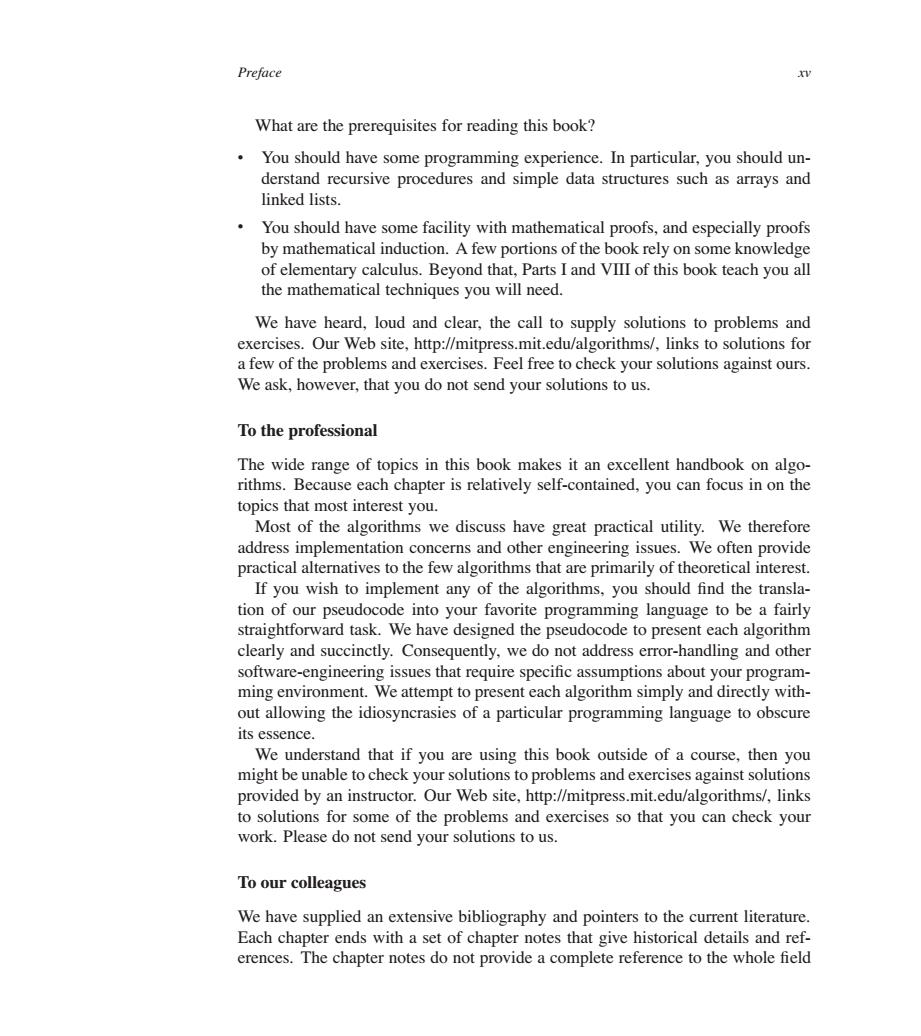正在加载图片...

Preface xv What are the prerequisites for reading this book? You should have some programming experience.In particular,you should un- derstand recursive procedures and simple data structures such as arrays and linked lists. You should have some facility with mathematical proofs,and especially proofs by mathematical induction.A few portions of the book rely on some knowledge of elementary calculus.Beyond that,Parts I and VIII of this book teach you all the mathematical techniques you will need. We have heard,loud and clear,the call to supply solutions to problems and exercises.Our Web site,http://mitpress.mit.edu/algorithms/,links to solutions for a few of the problems and exercises.Feel free to check your solutions against ours. We ask,however,that you do not send your solutions to us. To the professional The wide range of topics in this book makes it an excellent handbook on algo- rithms.Because each chapter is relatively self-contained,you can focus in on the topics that most interest you. Most of the algorithms we discuss have great practical utility.We therefore address implementation concerns and other engineering issues.We often provide practical alternatives to the few algorithms that are primarily of theoretical interest. If you wish to implement any of the algorithms,you should find the transla- tion of our pseudocode into your favorite programming language to be a fairly straightforward task.We have designed the pseudocode to present each algorithm clearly and succinctly.Consequently,we do not address error-handling and other software-engineering issues that require specific assumptions about your program- ming environment.We attempt to present each algorithm simply and directly with- out allowing the idiosyncrasies of a particular programming language to obscure its essence. We understand that if you are using this book outside of a course,then you might be unable to check your solutions to problems and exercises against solutions provided by an instructor.Our Web site,http://mitpress.mit.edu/algorithms/,links to solutions for some of the problems and exercises so that you can check your work.Please do not send your solutions to us. To our colleagues We have supplied an extensive bibliography and pointers to the current literature. Each chapter ends with a set of chapter notes that give historical details and ref- erences.The chapter notes do not provide a complete reference to the whole fieldPreface xv What are the prerequisites for reading this book? You should have some programming experience. In particular, you should understand recursive procedures and simple data structures such as arrays and linked lists. You should have some facility with mathematical proofs, and especially proofs by mathematical induction. A few portions of the book rely on some knowledge of elementary calculus. Beyond that, Parts I and VIII of this book teach you all the mathematical techniques you will need. We have heard, loud and clear, the call to supply solutions to problems and exercises. Our Web site, http://mitpress.mit.edu/algorithms/, links to solutions for a few of the problems and exercises. Feel free to check your solutions against ours. We ask, however, that you do not send your solutions to us. To the professional The wide range of topics in this book makes it an excellent handbook on algorithms. Because each chapter is relatively self-contained, you can focus in on the topics that most interest you. Most of the algorithms we discuss have great practical utility. We therefore address implementation concerns and other engineering issues. We often provide practical alternatives to the few algorithms that are primarily of theoretical interest. If you wish to implement any of the algorithms, you should find the translation of our pseudocode into your favorite programming language to be a fairly straightforward task. We have designed the pseudocode to present each algorithm clearly and succinctly. Consequently, we do not address error-handling and other software-engineering issues that require specific assumptions about your programming environment. We attempt to present each algorithm simply and directly without allowing the idiosyncrasies of a particular programming language to obscure its essence. We understand that if you are using this book outside of a course, then you might be unable to check your solutions to problems and exercises against solutions provided by an instructor. Our Web site, http://mitpress.mit.edu/algorithms/, links to solutions for some of the problems and exercises so that you can check your work. Please do not send your solutions to us. To our colleagues We have supplied an extensive bibliography and pointers to the current literature. Each chapter ends with a set of chapter notes that give historical details and references. The chapter notes do not provide a complete reference to the whole field��